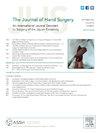上肢损伤恢复过程中,未受伤手臂疼痛是否与消极想法和苦恼有关?
IF 2.1
2区 医学
Q2 ORTHOPEDICS
引用次数: 0
摘要
目的:在上肢损伤的恢复过程中,患者有时会表达对与未损伤肢体增加使用相关的疼痛的担忧。担心与增加使用相关的不适可能是一种无益想法的表现,如灾难性思维或运动恐惧症。我们问了以下问题:(1)在孤立的单侧上肢损伤恢复期的患者中,未受伤手臂的疼痛强度是否与有关症状的无益想法和痛苦感觉有关,是否考虑了其他因素?(2)受伤肢体的疼痛强度、疼痛能力的大小或疼痛的适应是否与有关症状的无益的想法和痛苦感有关?方法:在这项横断面研究中,患者向肌肉骨骼专家提交上肢损伤治疗的新患者或复发患者,患者完成了用于测量以下内容的量表:未受伤手臂的疼痛强度,受伤手臂的疼痛强度,上肢特定能力的大小,抑郁症状,健康焦虑症状,灾难性思维和疼痛适应。采用多变量分析评估与未受伤手臂疼痛强度、受伤手臂疼痛强度、能力大小和疼痛调节相关的因素,控制其他人口统计学和损伤相关因素。结果:在未受伤和受伤的手臂中,更大的疼痛强度与更大的关于症状的无益思维独立相关。更大程度的能力和疼痛适应与更少的关于症状的无益思考独立相关。结论:考虑到未损伤上肢的疼痛强度越大,与更大的无益思维相关,临床医生可以协调患者对侧疼痛的担忧。临床医生可以通过评估未受伤的肢体以及识别和改善有关症状的无用想法来促进上肢损伤的恢复。研究类型/证据水平:预后II。本文章由计算机程序翻译,如有差异,请以英文原文为准。
Is Pain in the Uninjured Arm Associated With Unhelpful Thoughts and Distress Regarding Symptoms During Recovery From Upper-Extremity Injury?
Purpose
During recovery from upper-extremity injury, patients sometimes express concerns regarding pain associated with increased use of the uninjured limb. Concerns about discomfort associated with increased use may represent a manifestation of unhelpful thoughts such as catastrophic thinking or kinesiophobia. We asked the following questions: (1) Among people recovering from an isolated unilateral upper-extremity injury, is pain intensity in the uninjured arm associated with unhelpful thoughts and feelings of distress regarding symptoms, accounting for other factors? (2) Is pain intensity in the injured extremity, magnitude of capability, or accommodation of pain associated with unhelpful thoughts and feelings of distress regarding symptoms?
Methods
In this cross-sectional study of new or returning patients presenting to a musculoskeletal specialist for care for an upper-extremity injury, the patients completed scales that were used to measure the following: pain intensity in the uninjured arm, pain intensity in the injured arm, upper-extremity–specific magnitude of capability, symptoms of depression, symptoms of health anxiety, catastrophic thinking, and accommodation of pain. Multivariable analysis was used to evaluate factors associated with pain intensity in the uninjured arm, pain intensity in the injured arm, magnitude of capability, and pain accommodation, controlling for other demographic and injury-related factors.
Results
Greater pain intensity in both uninjured and injured arms was independently associated with greater unhelpful thinking regarding symptoms. A greater magnitude of capability and pain accommodation were independently associated with less unhelpful thinking regarding symptoms.
Conclusions
Given that greater pain intensity in the uninjured upper extremity is associated with greater unhelpful thinking, clinicians can be attuned to patient concerns about contralateral pain. Clinicians can facilitate recovery from upper-extremity injury by evaluating the uninjured limb as well as identifying and ameliorating unhelpful thinking regarding symptoms.
Type of study/level of evidence
Prognostic II.
求助全文
通过发布文献求助,成功后即可免费获取论文全文。
去求助
来源期刊
CiteScore
3.20
自引率
10.50%
发文量
402
审稿时长
12 weeks
期刊介绍:
The Journal of Hand Surgery publishes original, peer-reviewed articles related to the pathophysiology, diagnosis, and treatment of diseases and conditions of the upper extremity; these include both clinical and basic science studies, along with case reports. Special features include Review Articles (including Current Concepts and The Hand Surgery Landscape), Reviews of Books and Media, and Letters to the Editor.

 求助内容:
求助内容: 应助结果提醒方式:
应助结果提醒方式:


